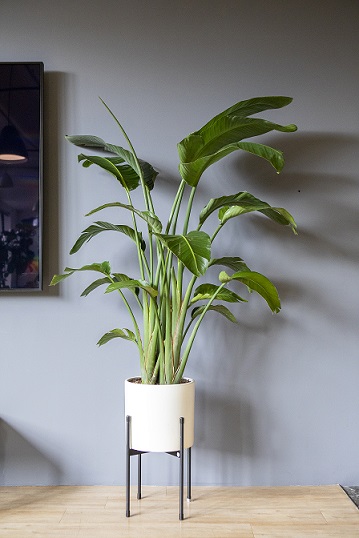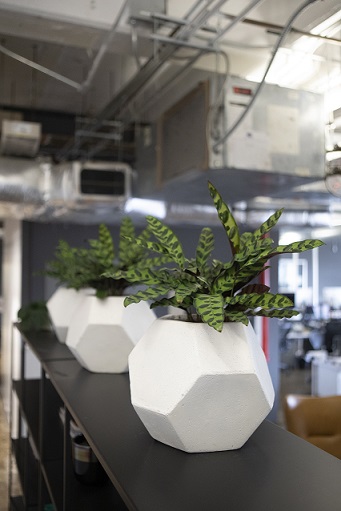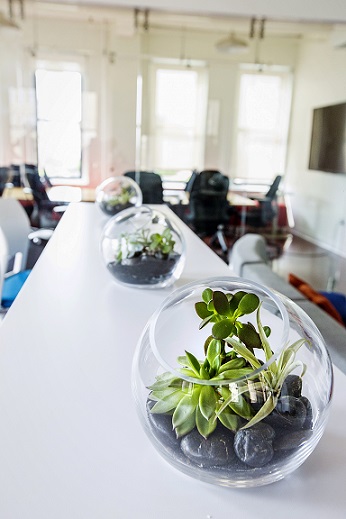So you want that gorgeous plant that you saw at your office, or a client's office, or in a building atrium. More and more, businesses see the real benefits of greening their spaces. John Mini uses a wide variety of tropicals to beautify indoor spaces, including palms, exotic figs, lush aroids and tough succulents. But now you would like to bring one of these beauties home, hopefully to enjoy for a long time. Here are a few tips for acclimating your new plant(s). To be practical, we will employ three simple categories: specimen plants, windowsill plants and succulents. (Of course, we at John Mini dig flowers, and we also use beautiful bromeliads and orchids. These will get their own future blog posts.)
Before we begin: Any time of year, make sure your new plant is protected on the way home—cold wind and hot sun can both do real damage.
Specimen plants

These are the big, impressive plants that come in 10” or 14” pots. Our varieties include aralias, several ficus species, several dracaenas, bird of paradise and a few palms. Assuming you can get one home, they may seem tempting, but acclimating big specimen plants is not always easy. Many of these big plants were grown under shade cloth in outdoor nurseries in Florida, where they thrived in bright light with relatively high humidity. Unobstructed east or south windows can work, but be prepared for a period of adjustment. Many ficus species, for example, will drop leaves in a new location. This is not just shock, by dropping leaves, the plant reduces surface area, thus minimizing water loss. If, like many New Yorkers, you are not blessed with great light (because of that neighboring building blocking your nice big windows), you may be forced to narrow your choices. However, many dracaenas (not D. marginata), snake plants, big aroids, Chamaeodora palms and scheffleras can all adapt to moderate light.
Three tips: One can use any balanced houseplant food. I would not start feeding until your plant shows some new growth, and then at half-strength. (Personally, I do not feed in the short days of winter). Second, water quality: Many monocots, including dracaenas, calatheas, marantas, and bromeliads can be burned by the small amounts of chlorine in tap water (the brown marks you sometimes see on dracaena leaves is caused by chlorine damage, not low humidity.) The solution is simple: If you get New York water, just let the water sit overnight--the chlorine will dissipate. Do not buy any nonsense about needing an R/O system--New York gets great water. (New Jersey may be another matter, as is any area where the water is hard.) Also, do not use a water softener—it adds some sodium to the water! Third, do not be in a hurry to repot. Many tropicals grow quite well being a bit underpotted. Besides, who has room for a 17 or 24” pot?
But, if even a 10” pot is too big, why not take home one or two smaller pots...
Windowsill plants

These are the four and six inch pots that decorate the tables and desks in many office settings. At John Mini, our selection includes aglaonemas, other aroids, calatheas and birds nest ferns. These beautiful tropicals can be found at big box stores, farmer's markets and several online retailers. Many of these varieties are understory plants, meaning they can adapt to lower light levels than the bigger specimen trees. However, smaller plants can present their own challenges; probably the most important is humidity. Why? Because of the square-cube law. Smaller objects have a greater surface area relative to their volume—which means they gain or lose water or heat at a faster rate. (It is also why plants in pots dry out faster than plants in the ground.) Bear in mind, increased watering does not compensate for low humidity.
Tips: First, do not locate plants near heaters or air conditioners. Second, grouping plants on grow tables can help increase ambient humidity. Third, consider a cool air humidifier. This is simply a humidifier without a heater, available in most drug stores. Again, I fertilize at half-strength, starting with the longer days in spring. Many smaller plants may seem to be almost dormant for a while, but when they adjust, you will be pleasantly surprised at the rate of new growth.
Succulents

Maybe you have a place with bright light, but like most of us, you find yourself with limited time. The good news is that succulents are the right plants for you. John Mini uses a wide variety, including several snake plant (sanseveria) species, ZZ plants (Zamioculcas, actually an aroid), haworthias, and kalanchoes. Several of these succulent species thrive on good light and occasional watering. They can be quite tolerant of neglect; at some of our client offices with big windows, they are often the most vibrant plants. As a general rule, haworthias, gasterias, ZZs and the flat-leaved sanseverias can tolerate moderate light; while aloes, kalanchoes, echeverias and cylindrical sanseverias enjoy brighter conditions. Of course, most true cacti need very bright light.
Tips: The biggest potential problem is overwatering, especially in dark or cooler conditions. Serious growers often use clay pots with a porous mix, such as a formula designed for cacti and other succulents. Many succulent varieties can get through winter with only a bit of water bi-weekly. As the days get brighter and warmer in spring, one can gradually increase watering to once a week. With patience, many succulent varieties will reward you with some interesting flowers!